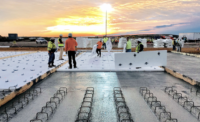LSA Bushmaster is a low but sprawling city rising in the desert about 150 miles south of Baghdad. LSA stands for "logistics staging area," and Bushmaster is swiftly becoming just that, the hub of an incredible stream of fighting machines, earthmoving equipment, cargo containers and helicopters flowing toward it across southern Iraq.
The roads are clogged day and night, with a near bumper-to-bumper parade of green and tan vehicles, all with cryptic battle markings in white paint stenciled on their doors and tailgates. The coded markings identify unit associations in the battle plan and help with swift organization of convoys.
The heavy traffic is putting a terrific strain on paved single-lane strips feeding the camp, particularly where they cross lightly engineered culverts and bridges. Bypasses are being developed around some troublesome areas, which often are little more than wallows through nearly impossible sand. Sometimes engineers find no choice but to break the traffic flow to make swift repairs. Drivers run the route at high levels of alert, as paramilitary attacks and snipers continue to harass them. The desert offers grim reminders along the way, in the form of wrecked, blasted, burned and stripped humvees, trucks and fighting vehicles.
 |
| CAUTION Equipment operators work in biochemical suits. |
Engineering tasks across Iraq are being broken down and parceled out. Some units are tasked with maintenance of the supply routes snaking almost 200 miles through the desert, while others are building helicopter pads and airstrips and pushing up berms for force protection around the villages of equipment and tents springing up for miles around.
On April 1, engineers from the 130th Brigade and its 864th Engineer Battalion were again scouting between Bushmaster and the advancing forces to investigate reports of water, fuel and construction material sources that could be directed to development of the camp. Their foraging has had many successes, including development of sources for gravel and high-quality clay and the appropriation of six 50-ton Russian dump trucks impressed into the construction project for a runway slated to begin landing C-130 cargo planes on April 2.
The heavy development of Bushmaster is partly the result of an evolving logistical strategy being shaped by events. "Logistics is interwoven into everything we do," says Brig. Gen. Charles Fletcher, commander of the Third Corps Support Command, the architect behind the logistical support structure for the U.S. Army's V Corps, which is commanding the ground assault. "We started with a very robust plan, and it would have worked if we could have been in Baghdad in the first five days." Those plans were modified "because the enemy decided to fight," he says. "We did not realize, obviously, what the level of resistance would be."
He says paramilitary groups are the surprise factor that has caused logistic revisions. Intermediate LSA's allowing drivers to make single-day turnarounds have been dropped in favor of longer runs and fewer facilities to develop and defend. And assault troops have slowed their advance to systematically reduce rear-area resistance and protect the supply lines.


Post a comment to this article
Report Abusive Comment